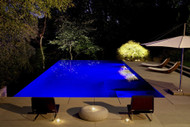4 Smart Reasons to Choose LED Pool Lights
Feb 27, 2017
Inground pools are a source of endless joy and fun throughout the summer months, or throughout the year in warmer climates—but they come with a cost, for maintenance, pool openings and closings, chemicals and accessories. Pool owners need to do the necessary research to get the best pool products possible for the least amount of money.
When choosing pool lights, consumers can opt for either traditional incandescent bulbs or LED pool lights. That’s kind of like choosing between 8-track tapes and DVDs for your car stereo system. Compared to incandescent bulbs, LED lights are more attractive, add greater visibility, last longer and reduce energy costs—just some of the reasons an increasing number of pool owners are converting to LED lights.
Here are 4 reasons LED lights are the best choice for pool lighting:
1. LED Lights Are More Attractive and Brighter
LED is shorthand for “light emitting diodes.” Aqua Magazine explains how the LED technology works.
That technology allows LED lights to produce a higher color (bluer) temperature than incandescent lights, one which permeates the water more efficiently and produces greater brightness. That greater level of visibility provides for added safety both in and around the pool during night swims. In addition, LED lights come in a variety of colors and allow for spectacular light shows not available with incandescent lights.
2. LED Lights Are More Durable
LED lights save pool owners money because they last longer. Incandescent bulbs have a shelf life of about 2,000 hours. LED lights typically last for more than 30,000 hours, about 15 times as long. That means LED lights don’t have to be replaced as often as incandescent lights—and that’s important in reducing the costs associated with service calls.
If you assume that pool lights are on an average of 12 hours a day, incandescent bulbs would need to be replaced after 166 days of use, or about every 5 months. LED lights used 12 hours a day will last 2,500 days, or about every 7 years. What’s more, incandescent bulbs don’t all go out at the same time, leaving pool owners with the choice of either having areas of the pool dark, or paying for even more service calls.
3. LED Lights Reduce Energy Costs
Because LED lights don’t become as hot as incandescent bulbs, they’re better at conserving energy. By most estimates, incandescent bulbs are only 20% energy efficient, meaning they lose about 80% of energy in the form of heat. LED lights are about 80% energy efficient—only 20% of the energy used is lost as heat—the remainder is used for light.
Equally important, LED lights require less wattage to provide the same amount of light. A “watt” is a measure of the amount of energy required to produce a certain amount of light. While incandescent lights use between 300 and 500 watts of power, LED lights use only 45 to 70 watts. Most pools will use about six lights to illuminate the pool at night. Comparing a 45-watt LED light to a 300-watt incandescent light bulb and assuming an electricity cost of 15 cents per kilowatt-hour, that amounts to an annual savings of $114 dollars per light, or a total annual savings of almost $700--or $7,000 over 10 years.
4. LED Lights Offer a Wide Variety of Choices
In addition to their aesthetic and financial advantages, LED lights offer consumers a wider variety of choices. For example, Fiberstars PAL-2000 Lights use a molded prismatic lens design to produce a soft, even light distribution and superior illumination. Another excellent choice is the PAL-2000 Color Change LED Light, which lets owners change the color effect of pool lighting with the flip of a switch. It features six colors, and comes with 2 digital effects, disco and color change.
Conclusion
LED pool lights are the obvious, smart consumer choice for new pool owners. They’re more attractive, brighter, require less maintenance, save on the monthly electric bill, and offer more choices than traditional incandescent lights. Pool owners who already have incandescent lights should inquire with their local pool supplier about converting to LED lights.

